Best Practices of Community Engagement: Charity Case Study Report
VerifiedAdded on 2023/01/04
|10
|2761
|79
Report
AI Summary
This report provides a comprehensive analysis of community engagement best practices, using 'Charity Begins at Home', a UK-based charity supporting homeless individuals, as a case study. The report details the company's operations, including its food distribution programs, volunteer-based model, and use of online platforms and social media to reach a wider audience. It examines the charity's best practices in community engagement, such as providing food and shelter, and stakeholder participation through transparent communication with local authorities, investors, volunteers, and beneficiaries. The report also discusses the challenges faced by the charity, including a lack of incentives, operational factors, and cultural differences, and outlines the strategies used to overcome these issues, such as pursuing equity in services and building an open platform for expression. The conclusion emphasizes the importance of community engagement and highlights the charity's commitment to fostering it through various methods, including making activities easy for society to participate and interact with. The report underscores the value of volunteer work and interpersonal skills in achieving the charity's objectives and improving the lives of the homeless people in the community.
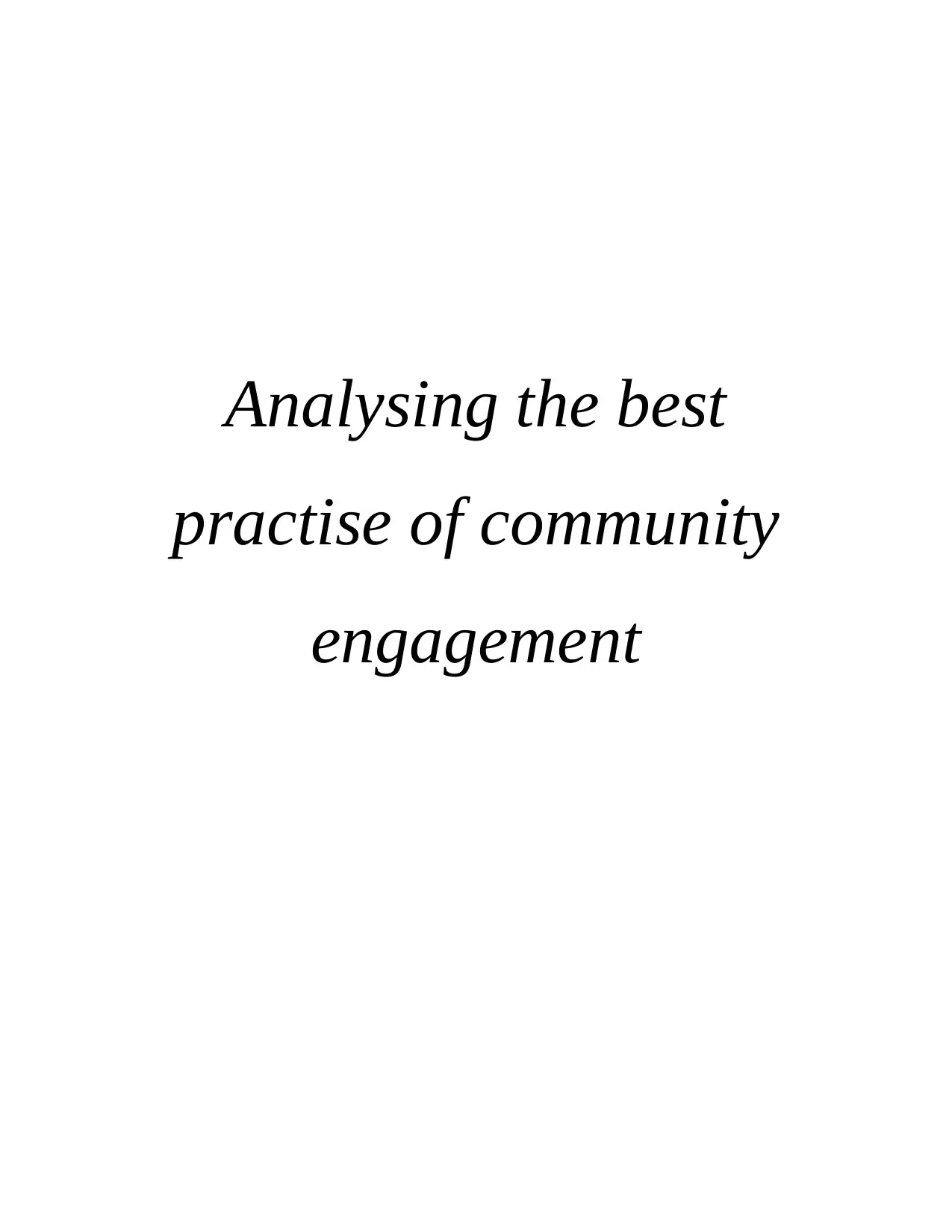
Analysing the best
practise of community
engagement
practise of community
engagement
Paraphrase This Document
Need a fresh take? Get an instant paraphrase of this document with our AI Paraphraser
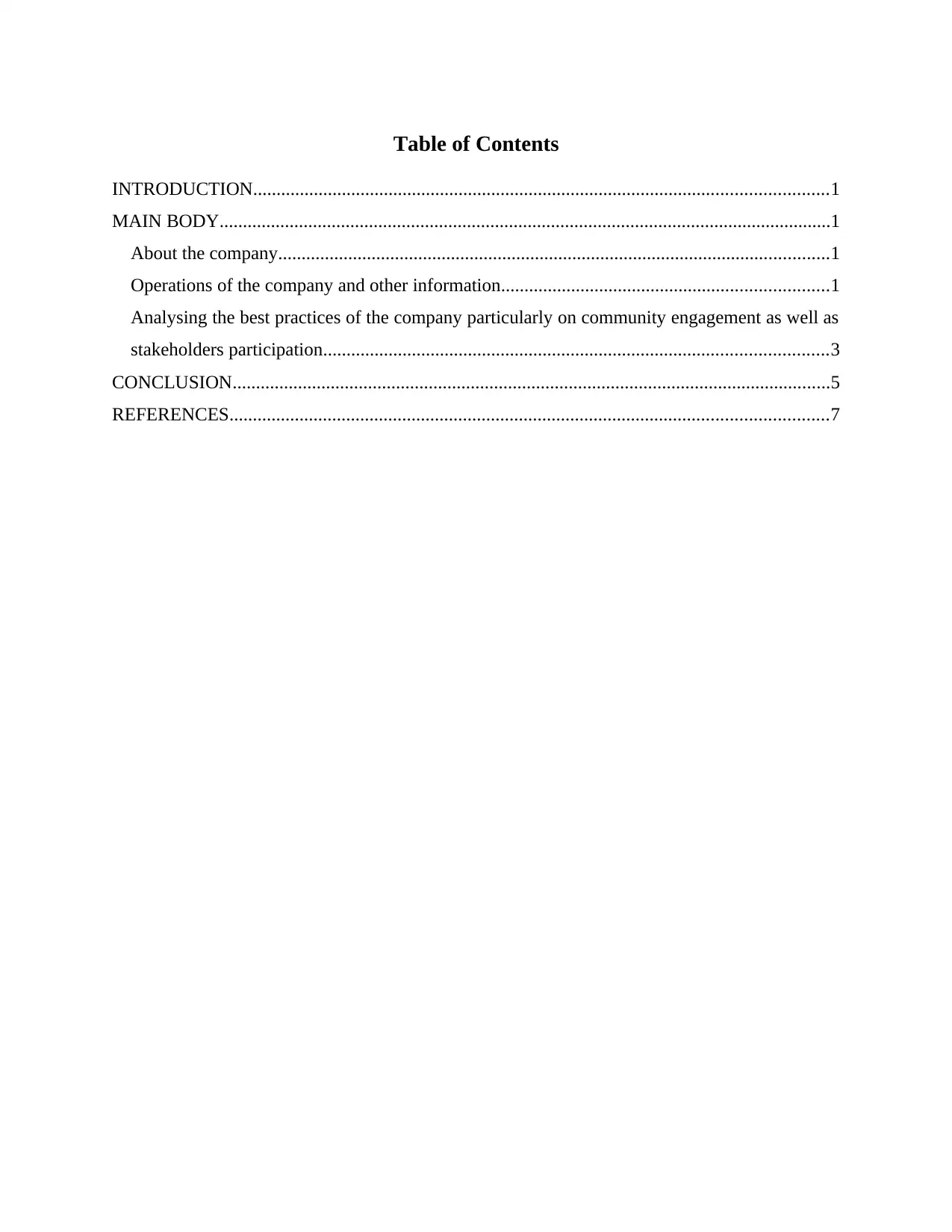
Table of Contents
INTRODUCTION...........................................................................................................................1
MAIN BODY...................................................................................................................................1
About the company......................................................................................................................1
Operations of the company and other information......................................................................1
Analysing the best practices of the company particularly on community engagement as well as
stakeholders participation............................................................................................................3
CONCLUSION................................................................................................................................5
REFERENCES................................................................................................................................7
INTRODUCTION...........................................................................................................................1
MAIN BODY...................................................................................................................................1
About the company......................................................................................................................1
Operations of the company and other information......................................................................1
Analysing the best practices of the company particularly on community engagement as well as
stakeholders participation............................................................................................................3
CONCLUSION................................................................................................................................5
REFERENCES................................................................................................................................7

⊘ This is a preview!⊘
Do you want full access?
Subscribe today to unlock all pages.

Trusted by 1+ million students worldwide
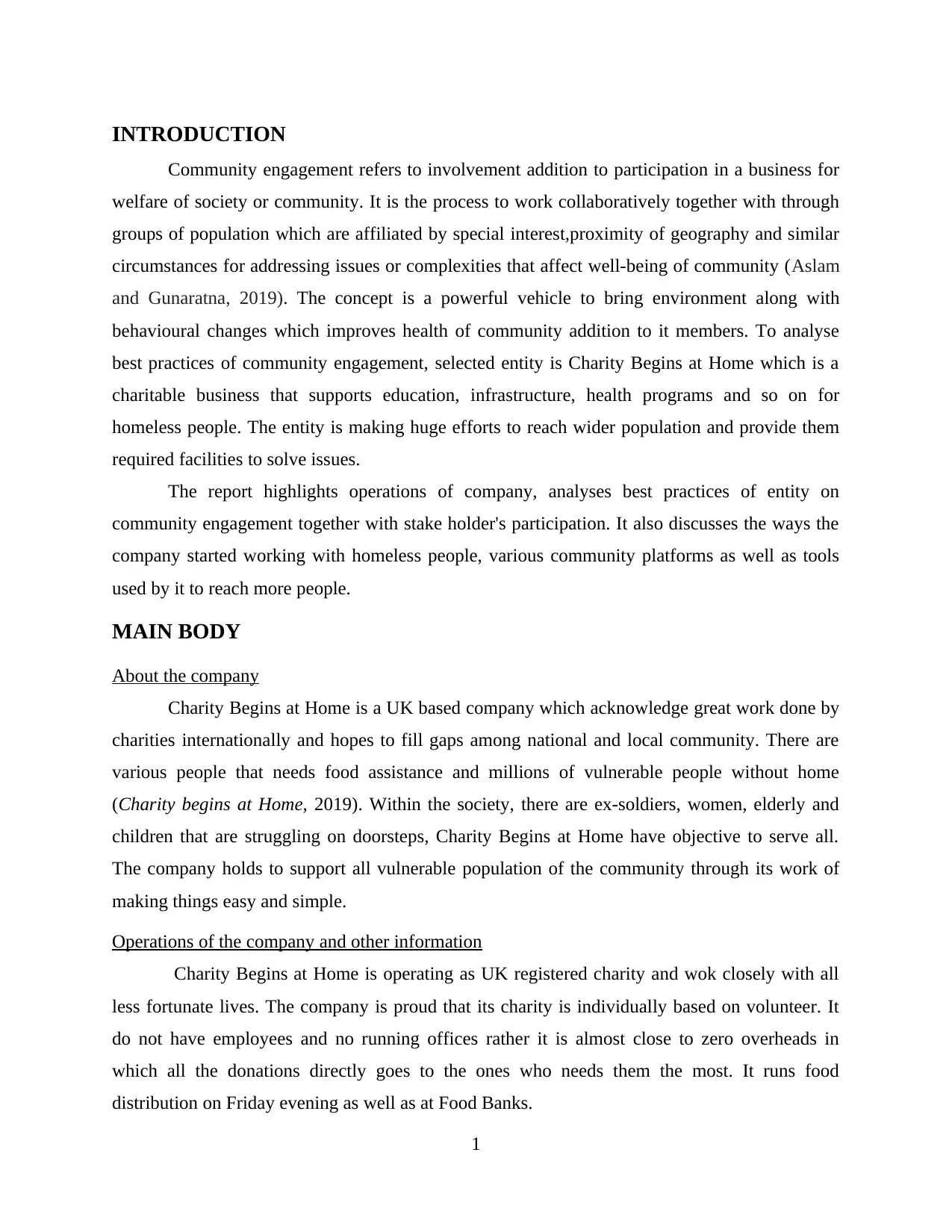
INTRODUCTION
Community engagement refers to involvement addition to participation in a business for
welfare of society or community. It is the process to work collaboratively together with through
groups of population which are affiliated by special interest,proximity of geography and similar
circumstances for addressing issues or complexities that affect well-being of community (Aslam
and Gunaratna, 2019). The concept is a powerful vehicle to bring environment along with
behavioural changes which improves health of community addition to it members. To analyse
best practices of community engagement, selected entity is Charity Begins at Home which is a
charitable business that supports education, infrastructure, health programs and so on for
homeless people. The entity is making huge efforts to reach wider population and provide them
required facilities to solve issues.
The report highlights operations of company, analyses best practices of entity on
community engagement together with stake holder's participation. It also discusses the ways the
company started working with homeless people, various community platforms as well as tools
used by it to reach more people.
MAIN BODY
About the company
Charity Begins at Home is a UK based company which acknowledge great work done by
charities internationally and hopes to fill gaps among national and local community. There are
various people that needs food assistance and millions of vulnerable people without home
(Charity begins at Home, 2019). Within the society, there are ex-soldiers, women, elderly and
children that are struggling on doorsteps, Charity Begins at Home have objective to serve all.
The company holds to support all vulnerable population of the community through its work of
making things easy and simple.
Operations of the company and other information
Charity Begins at Home is operating as UK registered charity and wok closely with all
less fortunate lives. The company is proud that its charity is individually based on volunteer. It
do not have employees and no running offices rather it is almost close to zero overheads in
which all the donations directly goes to the ones who needs them the most. It runs food
distribution on Friday evening as well as at Food Banks.
1
Community engagement refers to involvement addition to participation in a business for
welfare of society or community. It is the process to work collaboratively together with through
groups of population which are affiliated by special interest,proximity of geography and similar
circumstances for addressing issues or complexities that affect well-being of community (Aslam
and Gunaratna, 2019). The concept is a powerful vehicle to bring environment along with
behavioural changes which improves health of community addition to it members. To analyse
best practices of community engagement, selected entity is Charity Begins at Home which is a
charitable business that supports education, infrastructure, health programs and so on for
homeless people. The entity is making huge efforts to reach wider population and provide them
required facilities to solve issues.
The report highlights operations of company, analyses best practices of entity on
community engagement together with stake holder's participation. It also discusses the ways the
company started working with homeless people, various community platforms as well as tools
used by it to reach more people.
MAIN BODY
About the company
Charity Begins at Home is a UK based company which acknowledge great work done by
charities internationally and hopes to fill gaps among national and local community. There are
various people that needs food assistance and millions of vulnerable people without home
(Charity begins at Home, 2019). Within the society, there are ex-soldiers, women, elderly and
children that are struggling on doorsteps, Charity Begins at Home have objective to serve all.
The company holds to support all vulnerable population of the community through its work of
making things easy and simple.
Operations of the company and other information
Charity Begins at Home is operating as UK registered charity and wok closely with all
less fortunate lives. The company is proud that its charity is individually based on volunteer. It
do not have employees and no running offices rather it is almost close to zero overheads in
which all the donations directly goes to the ones who needs them the most. It runs food
distribution on Friday evening as well as at Food Banks.
1
Paraphrase This Document
Need a fresh take? Get an instant paraphrase of this document with our AI Paraphraser
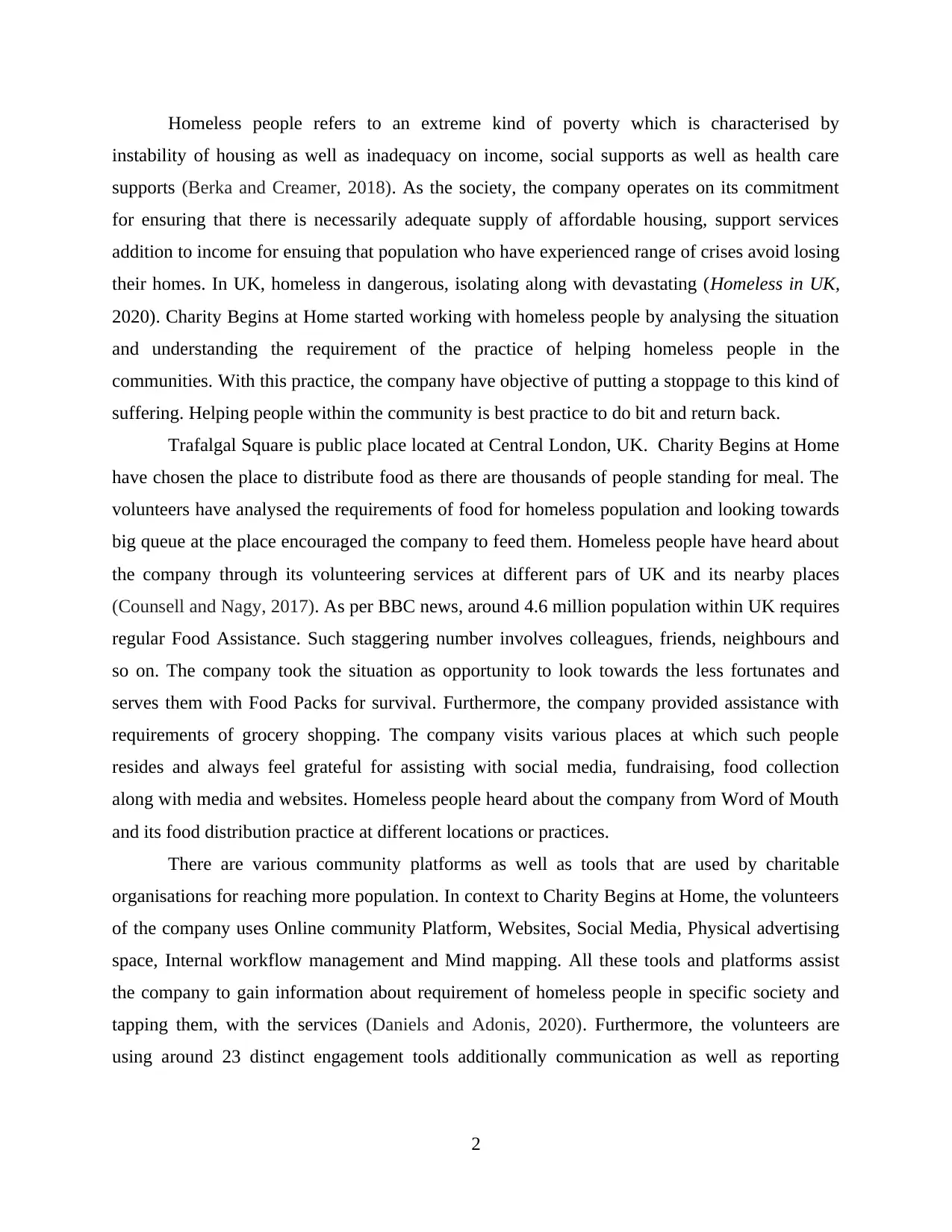
Homeless people refers to an extreme kind of poverty which is characterised by
instability of housing as well as inadequacy on income, social supports as well as health care
supports (Berka and Creamer, 2018). As the society, the company operates on its commitment
for ensuring that there is necessarily adequate supply of affordable housing, support services
addition to income for ensuing that population who have experienced range of crises avoid losing
their homes. In UK, homeless in dangerous, isolating along with devastating (Homeless in UK,
2020). Charity Begins at Home started working with homeless people by analysing the situation
and understanding the requirement of the practice of helping homeless people in the
communities. With this practice, the company have objective of putting a stoppage to this kind of
suffering. Helping people within the community is best practice to do bit and return back.
Trafalgal Square is public place located at Central London, UK. Charity Begins at Home
have chosen the place to distribute food as there are thousands of people standing for meal. The
volunteers have analysed the requirements of food for homeless population and looking towards
big queue at the place encouraged the company to feed them. Homeless people have heard about
the company through its volunteering services at different pars of UK and its nearby places
(Counsell and Nagy, 2017). As per BBC news, around 4.6 million population within UK requires
regular Food Assistance. Such staggering number involves colleagues, friends, neighbours and
so on. The company took the situation as opportunity to look towards the less fortunates and
serves them with Food Packs for survival. Furthermore, the company provided assistance with
requirements of grocery shopping. The company visits various places at which such people
resides and always feel grateful for assisting with social media, fundraising, food collection
along with media and websites. Homeless people heard about the company from Word of Mouth
and its food distribution practice at different locations or practices.
There are various community platforms as well as tools that are used by charitable
organisations for reaching more population. In context to Charity Begins at Home, the volunteers
of the company uses Online community Platform, Websites, Social Media, Physical advertising
space, Internal workflow management and Mind mapping. All these tools and platforms assist
the company to gain information about requirement of homeless people in specific society and
tapping them, with the services (Daniels and Adonis, 2020). Furthermore, the volunteers are
using around 23 distinct engagement tools additionally communication as well as reporting
2
instability of housing as well as inadequacy on income, social supports as well as health care
supports (Berka and Creamer, 2018). As the society, the company operates on its commitment
for ensuring that there is necessarily adequate supply of affordable housing, support services
addition to income for ensuing that population who have experienced range of crises avoid losing
their homes. In UK, homeless in dangerous, isolating along with devastating (Homeless in UK,
2020). Charity Begins at Home started working with homeless people by analysing the situation
and understanding the requirement of the practice of helping homeless people in the
communities. With this practice, the company have objective of putting a stoppage to this kind of
suffering. Helping people within the community is best practice to do bit and return back.
Trafalgal Square is public place located at Central London, UK. Charity Begins at Home
have chosen the place to distribute food as there are thousands of people standing for meal. The
volunteers have analysed the requirements of food for homeless population and looking towards
big queue at the place encouraged the company to feed them. Homeless people have heard about
the company through its volunteering services at different pars of UK and its nearby places
(Counsell and Nagy, 2017). As per BBC news, around 4.6 million population within UK requires
regular Food Assistance. Such staggering number involves colleagues, friends, neighbours and
so on. The company took the situation as opportunity to look towards the less fortunates and
serves them with Food Packs for survival. Furthermore, the company provided assistance with
requirements of grocery shopping. The company visits various places at which such people
resides and always feel grateful for assisting with social media, fundraising, food collection
along with media and websites. Homeless people heard about the company from Word of Mouth
and its food distribution practice at different locations or practices.
There are various community platforms as well as tools that are used by charitable
organisations for reaching more population. In context to Charity Begins at Home, the volunteers
of the company uses Online community Platform, Websites, Social Media, Physical advertising
space, Internal workflow management and Mind mapping. All these tools and platforms assist
the company to gain information about requirement of homeless people in specific society and
tapping them, with the services (Daniels and Adonis, 2020). Furthermore, the volunteers are
using around 23 distinct engagement tools additionally communication as well as reporting
2
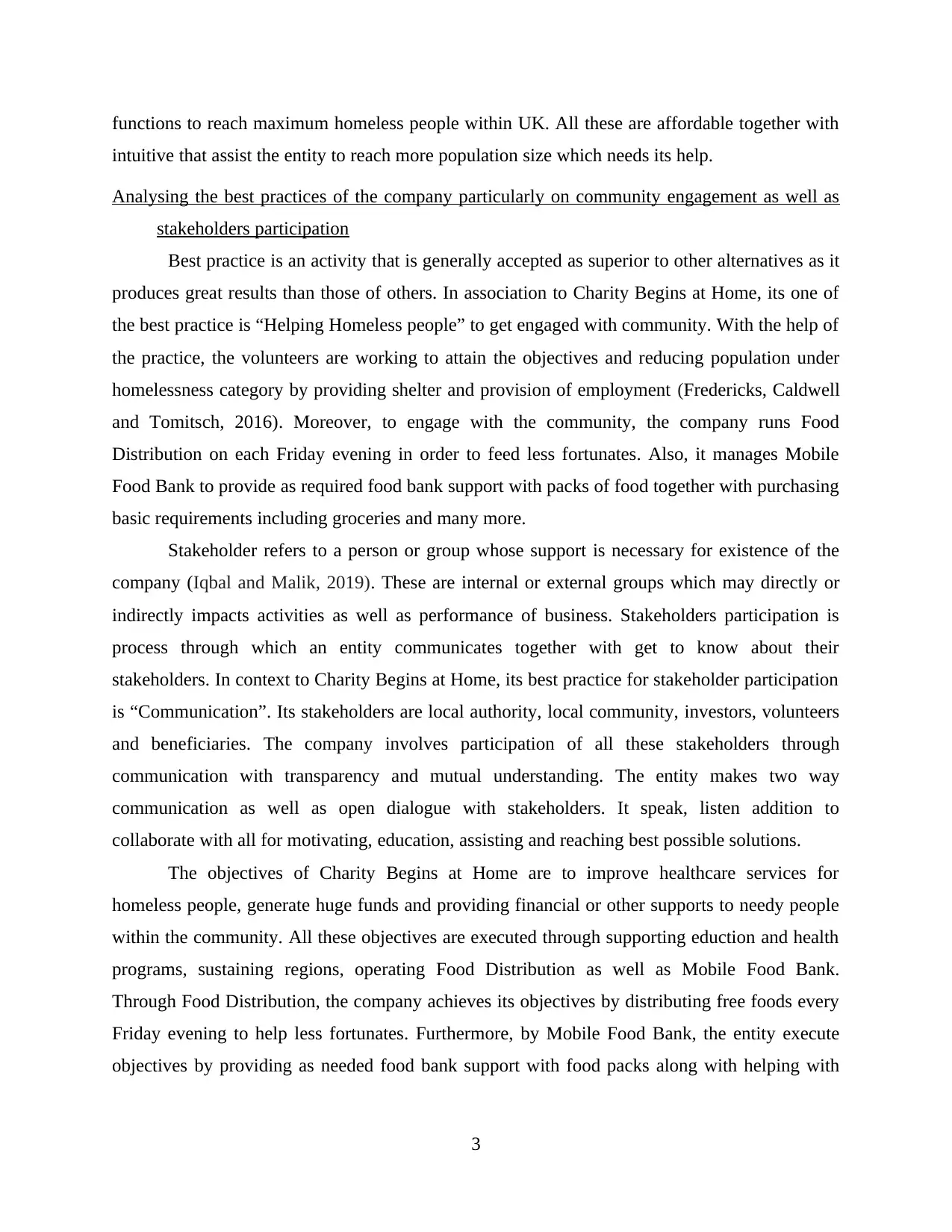
functions to reach maximum homeless people within UK. All these are affordable together with
intuitive that assist the entity to reach more population size which needs its help.
Analysing the best practices of the company particularly on community engagement as well as
stakeholders participation
Best practice is an activity that is generally accepted as superior to other alternatives as it
produces great results than those of others. In association to Charity Begins at Home, its one of
the best practice is “Helping Homeless people” to get engaged with community. With the help of
the practice, the volunteers are working to attain the objectives and reducing population under
homelessness category by providing shelter and provision of employment (Fredericks, Caldwell
and Tomitsch, 2016). Moreover, to engage with the community, the company runs Food
Distribution on each Friday evening in order to feed less fortunates. Also, it manages Mobile
Food Bank to provide as required food bank support with packs of food together with purchasing
basic requirements including groceries and many more.
Stakeholder refers to a person or group whose support is necessary for existence of the
company (Iqbal and Malik, 2019). These are internal or external groups which may directly or
indirectly impacts activities as well as performance of business. Stakeholders participation is
process through which an entity communicates together with get to know about their
stakeholders. In context to Charity Begins at Home, its best practice for stakeholder participation
is “Communication”. Its stakeholders are local authority, local community, investors, volunteers
and beneficiaries. The company involves participation of all these stakeholders through
communication with transparency and mutual understanding. The entity makes two way
communication as well as open dialogue with stakeholders. It speak, listen addition to
collaborate with all for motivating, education, assisting and reaching best possible solutions.
The objectives of Charity Begins at Home are to improve healthcare services for
homeless people, generate huge funds and providing financial or other supports to needy people
within the community. All these objectives are executed through supporting eduction and health
programs, sustaining regions, operating Food Distribution as well as Mobile Food Bank.
Through Food Distribution, the company achieves its objectives by distributing free foods every
Friday evening to help less fortunates. Furthermore, by Mobile Food Bank, the entity execute
objectives by providing as needed food bank support with food packs along with helping with
3
intuitive that assist the entity to reach more population size which needs its help.
Analysing the best practices of the company particularly on community engagement as well as
stakeholders participation
Best practice is an activity that is generally accepted as superior to other alternatives as it
produces great results than those of others. In association to Charity Begins at Home, its one of
the best practice is “Helping Homeless people” to get engaged with community. With the help of
the practice, the volunteers are working to attain the objectives and reducing population under
homelessness category by providing shelter and provision of employment (Fredericks, Caldwell
and Tomitsch, 2016). Moreover, to engage with the community, the company runs Food
Distribution on each Friday evening in order to feed less fortunates. Also, it manages Mobile
Food Bank to provide as required food bank support with packs of food together with purchasing
basic requirements including groceries and many more.
Stakeholder refers to a person or group whose support is necessary for existence of the
company (Iqbal and Malik, 2019). These are internal or external groups which may directly or
indirectly impacts activities as well as performance of business. Stakeholders participation is
process through which an entity communicates together with get to know about their
stakeholders. In context to Charity Begins at Home, its best practice for stakeholder participation
is “Communication”. Its stakeholders are local authority, local community, investors, volunteers
and beneficiaries. The company involves participation of all these stakeholders through
communication with transparency and mutual understanding. The entity makes two way
communication as well as open dialogue with stakeholders. It speak, listen addition to
collaborate with all for motivating, education, assisting and reaching best possible solutions.
The objectives of Charity Begins at Home are to improve healthcare services for
homeless people, generate huge funds and providing financial or other supports to needy people
within the community. All these objectives are executed through supporting eduction and health
programs, sustaining regions, operating Food Distribution as well as Mobile Food Bank.
Through Food Distribution, the company achieves its objectives by distributing free foods every
Friday evening to help less fortunates. Furthermore, by Mobile Food Bank, the entity execute
objectives by providing as needed food bank support with food packs along with helping with
3
⊘ This is a preview!⊘
Do you want full access?
Subscribe today to unlock all pages.

Trusted by 1+ million students worldwide
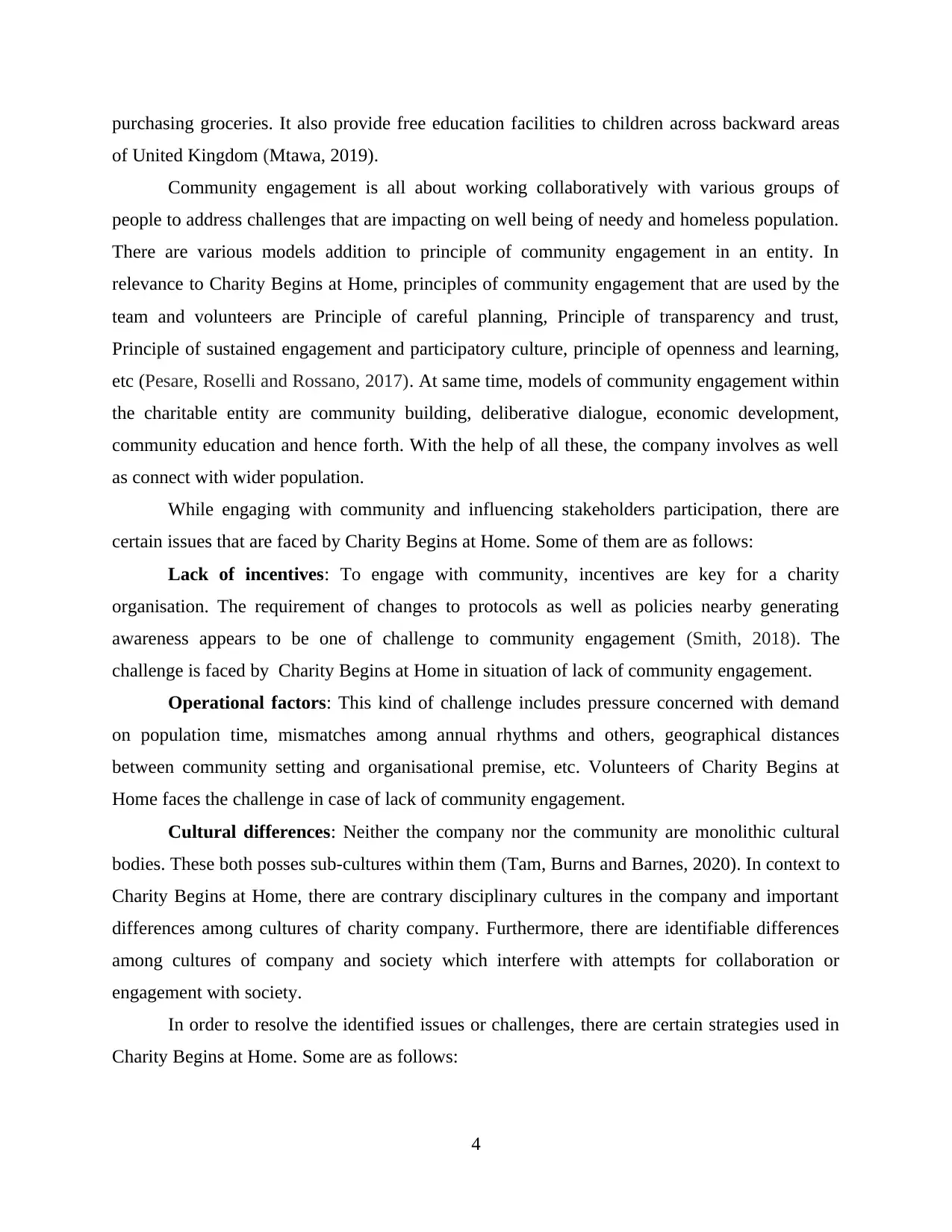
purchasing groceries. It also provide free education facilities to children across backward areas
of United Kingdom (Mtawa, 2019).
Community engagement is all about working collaboratively with various groups of
people to address challenges that are impacting on well being of needy and homeless population.
There are various models addition to principle of community engagement in an entity. In
relevance to Charity Begins at Home, principles of community engagement that are used by the
team and volunteers are Principle of careful planning, Principle of transparency and trust,
Principle of sustained engagement and participatory culture, principle of openness and learning,
etc (Pesare, Roselli and Rossano, 2017). At same time, models of community engagement within
the charitable entity are community building, deliberative dialogue, economic development,
community education and hence forth. With the help of all these, the company involves as well
as connect with wider population.
While engaging with community and influencing stakeholders participation, there are
certain issues that are faced by Charity Begins at Home. Some of them are as follows:
Lack of incentives: To engage with community, incentives are key for a charity
organisation. The requirement of changes to protocols as well as policies nearby generating
awareness appears to be one of challenge to community engagement (Smith, 2018). The
challenge is faced by Charity Begins at Home in situation of lack of community engagement.
Operational factors: This kind of challenge includes pressure concerned with demand
on population time, mismatches among annual rhythms and others, geographical distances
between community setting and organisational premise, etc. Volunteers of Charity Begins at
Home faces the challenge in case of lack of community engagement.
Cultural differences: Neither the company nor the community are monolithic cultural
bodies. These both posses sub-cultures within them (Tam, Burns and Barnes, 2020). In context to
Charity Begins at Home, there are contrary disciplinary cultures in the company and important
differences among cultures of charity company. Furthermore, there are identifiable differences
among cultures of company and society which interfere with attempts for collaboration or
engagement with society.
In order to resolve the identified issues or challenges, there are certain strategies used in
Charity Begins at Home. Some are as follows:
4
of United Kingdom (Mtawa, 2019).
Community engagement is all about working collaboratively with various groups of
people to address challenges that are impacting on well being of needy and homeless population.
There are various models addition to principle of community engagement in an entity. In
relevance to Charity Begins at Home, principles of community engagement that are used by the
team and volunteers are Principle of careful planning, Principle of transparency and trust,
Principle of sustained engagement and participatory culture, principle of openness and learning,
etc (Pesare, Roselli and Rossano, 2017). At same time, models of community engagement within
the charitable entity are community building, deliberative dialogue, economic development,
community education and hence forth. With the help of all these, the company involves as well
as connect with wider population.
While engaging with community and influencing stakeholders participation, there are
certain issues that are faced by Charity Begins at Home. Some of them are as follows:
Lack of incentives: To engage with community, incentives are key for a charity
organisation. The requirement of changes to protocols as well as policies nearby generating
awareness appears to be one of challenge to community engagement (Smith, 2018). The
challenge is faced by Charity Begins at Home in situation of lack of community engagement.
Operational factors: This kind of challenge includes pressure concerned with demand
on population time, mismatches among annual rhythms and others, geographical distances
between community setting and organisational premise, etc. Volunteers of Charity Begins at
Home faces the challenge in case of lack of community engagement.
Cultural differences: Neither the company nor the community are monolithic cultural
bodies. These both posses sub-cultures within them (Tam, Burns and Barnes, 2020). In context to
Charity Begins at Home, there are contrary disciplinary cultures in the company and important
differences among cultures of charity company. Furthermore, there are identifiable differences
among cultures of company and society which interfere with attempts for collaboration or
engagement with society.
In order to resolve the identified issues or challenges, there are certain strategies used in
Charity Begins at Home. Some are as follows:
4
Paraphrase This Document
Need a fresh take? Get an instant paraphrase of this document with our AI Paraphraser
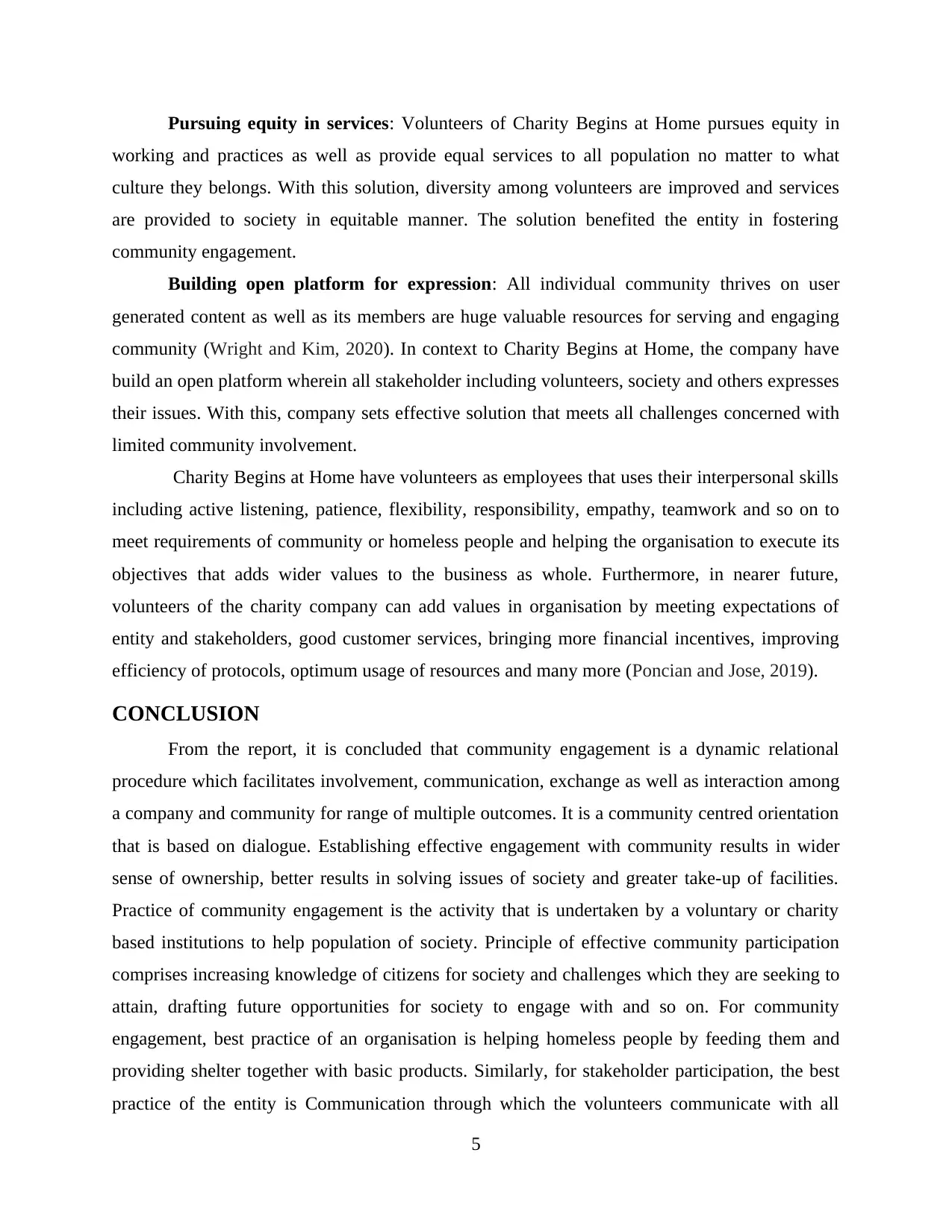
Pursuing equity in services: Volunteers of Charity Begins at Home pursues equity in
working and practices as well as provide equal services to all population no matter to what
culture they belongs. With this solution, diversity among volunteers are improved and services
are provided to society in equitable manner. The solution benefited the entity in fostering
community engagement.
Building open platform for expression: All individual community thrives on user
generated content as well as its members are huge valuable resources for serving and engaging
community (Wright and Kim, 2020). In context to Charity Begins at Home, the company have
build an open platform wherein all stakeholder including volunteers, society and others expresses
their issues. With this, company sets effective solution that meets all challenges concerned with
limited community involvement.
Charity Begins at Home have volunteers as employees that uses their interpersonal skills
including active listening, patience, flexibility, responsibility, empathy, teamwork and so on to
meet requirements of community or homeless people and helping the organisation to execute its
objectives that adds wider values to the business as whole. Furthermore, in nearer future,
volunteers of the charity company can add values in organisation by meeting expectations of
entity and stakeholders, good customer services, bringing more financial incentives, improving
efficiency of protocols, optimum usage of resources and many more (Poncian and Jose, 2019).
CONCLUSION
From the report, it is concluded that community engagement is a dynamic relational
procedure which facilitates involvement, communication, exchange as well as interaction among
a company and community for range of multiple outcomes. It is a community centred orientation
that is based on dialogue. Establishing effective engagement with community results in wider
sense of ownership, better results in solving issues of society and greater take-up of facilities.
Practice of community engagement is the activity that is undertaken by a voluntary or charity
based institutions to help population of society. Principle of effective community participation
comprises increasing knowledge of citizens for society and challenges which they are seeking to
attain, drafting future opportunities for society to engage with and so on. For community
engagement, best practice of an organisation is helping homeless people by feeding them and
providing shelter together with basic products. Similarly, for stakeholder participation, the best
practice of the entity is Communication through which the volunteers communicate with all
5
working and practices as well as provide equal services to all population no matter to what
culture they belongs. With this solution, diversity among volunteers are improved and services
are provided to society in equitable manner. The solution benefited the entity in fostering
community engagement.
Building open platform for expression: All individual community thrives on user
generated content as well as its members are huge valuable resources for serving and engaging
community (Wright and Kim, 2020). In context to Charity Begins at Home, the company have
build an open platform wherein all stakeholder including volunteers, society and others expresses
their issues. With this, company sets effective solution that meets all challenges concerned with
limited community involvement.
Charity Begins at Home have volunteers as employees that uses their interpersonal skills
including active listening, patience, flexibility, responsibility, empathy, teamwork and so on to
meet requirements of community or homeless people and helping the organisation to execute its
objectives that adds wider values to the business as whole. Furthermore, in nearer future,
volunteers of the charity company can add values in organisation by meeting expectations of
entity and stakeholders, good customer services, bringing more financial incentives, improving
efficiency of protocols, optimum usage of resources and many more (Poncian and Jose, 2019).
CONCLUSION
From the report, it is concluded that community engagement is a dynamic relational
procedure which facilitates involvement, communication, exchange as well as interaction among
a company and community for range of multiple outcomes. It is a community centred orientation
that is based on dialogue. Establishing effective engagement with community results in wider
sense of ownership, better results in solving issues of society and greater take-up of facilities.
Practice of community engagement is the activity that is undertaken by a voluntary or charity
based institutions to help population of society. Principle of effective community participation
comprises increasing knowledge of citizens for society and challenges which they are seeking to
attain, drafting future opportunities for society to engage with and so on. For community
engagement, best practice of an organisation is helping homeless people by feeding them and
providing shelter together with basic products. Similarly, for stakeholder participation, the best
practice of the entity is Communication through which the volunteers communicate with all
5
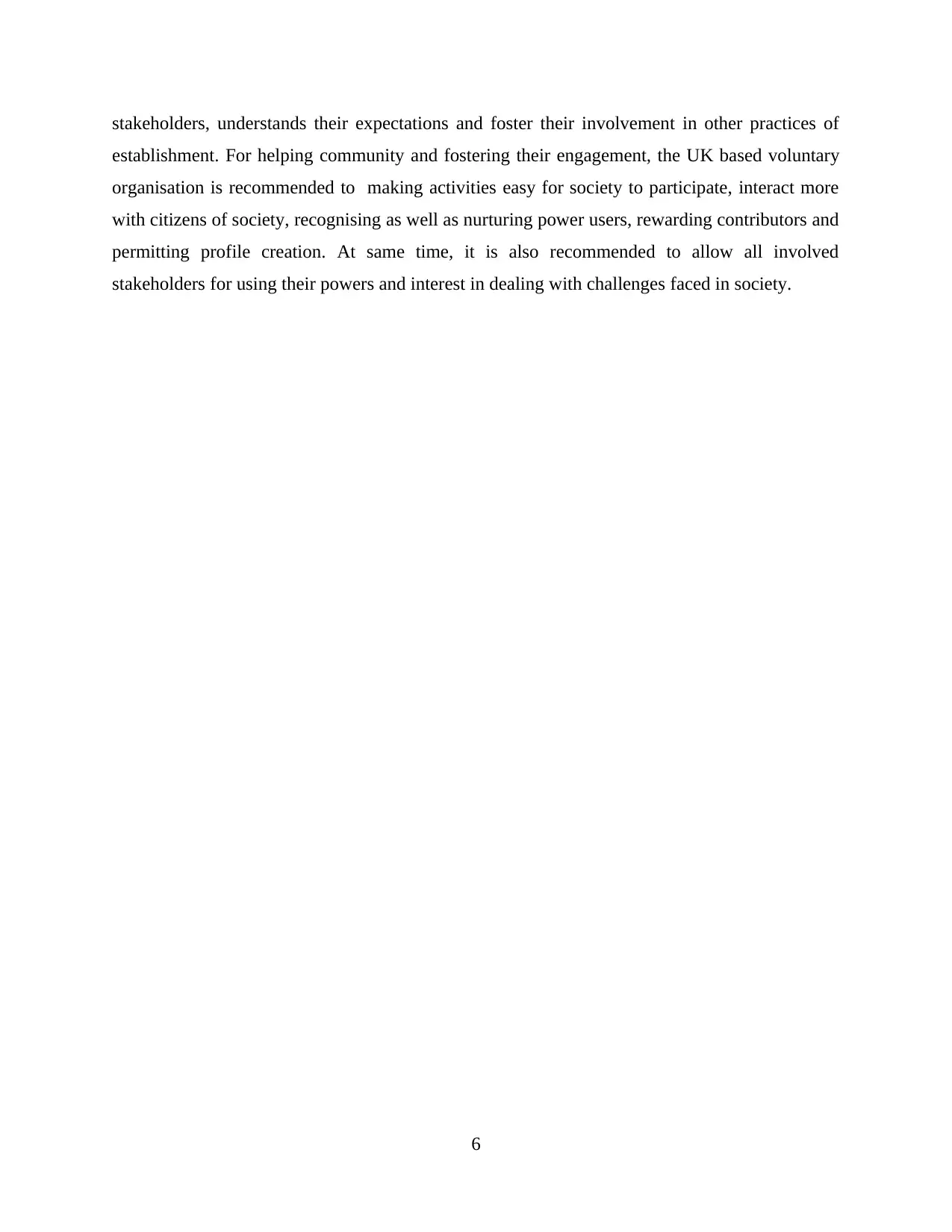
stakeholders, understands their expectations and foster their involvement in other practices of
establishment. For helping community and fostering their engagement, the UK based voluntary
organisation is recommended to making activities easy for society to participate, interact more
with citizens of society, recognising as well as nurturing power users, rewarding contributors and
permitting profile creation. At same time, it is also recommended to allow all involved
stakeholders for using their powers and interest in dealing with challenges faced in society.
6
establishment. For helping community and fostering their engagement, the UK based voluntary
organisation is recommended to making activities easy for society to participate, interact more
with citizens of society, recognising as well as nurturing power users, rewarding contributors and
permitting profile creation. At same time, it is also recommended to allow all involved
stakeholders for using their powers and interest in dealing with challenges faced in society.
6
⊘ This is a preview!⊘
Do you want full access?
Subscribe today to unlock all pages.

Trusted by 1+ million students worldwide
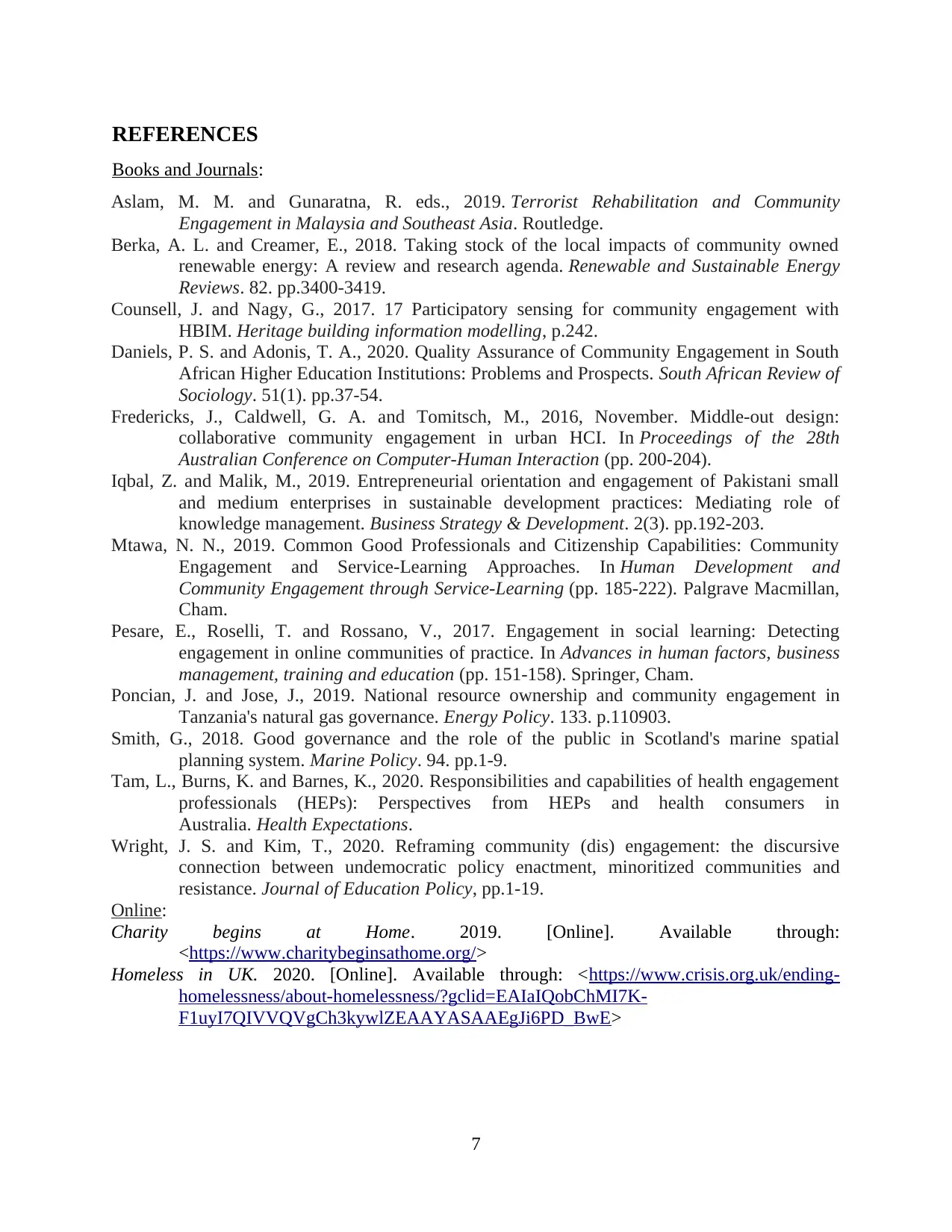
REFERENCES
Books and Journals:
Aslam, M. M. and Gunaratna, R. eds., 2019. Terrorist Rehabilitation and Community
Engagement in Malaysia and Southeast Asia. Routledge.
Berka, A. L. and Creamer, E., 2018. Taking stock of the local impacts of community owned
renewable energy: A review and research agenda. Renewable and Sustainable Energy
Reviews. 82. pp.3400-3419.
Counsell, J. and Nagy, G., 2017. 17 Participatory sensing for community engagement with
HBIM. Heritage building information modelling, p.242.
Daniels, P. S. and Adonis, T. A., 2020. Quality Assurance of Community Engagement in South
African Higher Education Institutions: Problems and Prospects. South African Review of
Sociology. 51(1). pp.37-54.
Fredericks, J., Caldwell, G. A. and Tomitsch, M., 2016, November. Middle-out design:
collaborative community engagement in urban HCI. In Proceedings of the 28th
Australian Conference on Computer-Human Interaction (pp. 200-204).
Iqbal, Z. and Malik, M., 2019. Entrepreneurial orientation and engagement of Pakistani small
and medium enterprises in sustainable development practices: Mediating role of
knowledge management. Business Strategy & Development. 2(3). pp.192-203.
Mtawa, N. N., 2019. Common Good Professionals and Citizenship Capabilities: Community
Engagement and Service-Learning Approaches. In Human Development and
Community Engagement through Service-Learning (pp. 185-222). Palgrave Macmillan,
Cham.
Pesare, E., Roselli, T. and Rossano, V., 2017. Engagement in social learning: Detecting
engagement in online communities of practice. In Advances in human factors, business
management, training and education (pp. 151-158). Springer, Cham.
Poncian, J. and Jose, J., 2019. National resource ownership and community engagement in
Tanzania's natural gas governance. Energy Policy. 133. p.110903.
Smith, G., 2018. Good governance and the role of the public in Scotland's marine spatial
planning system. Marine Policy. 94. pp.1-9.
Tam, L., Burns, K. and Barnes, K., 2020. Responsibilities and capabilities of health engagement
professionals (HEPs): Perspectives from HEPs and health consumers in
Australia. Health Expectations.
Wright, J. S. and Kim, T., 2020. Reframing community (dis) engagement: the discursive
connection between undemocratic policy enactment, minoritized communities and
resistance. Journal of Education Policy, pp.1-19.
Online:
Charity begins at Home. 2019. [Online]. Available through:
<https://www.charitybeginsathome.org/>
Homeless in UK. 2020. [Online]. Available through: <https://www.crisis.org.uk/ending-
homelessness/about-homelessness/?gclid=EAIaIQobChMI7K-
F1uyI7QIVVQVgCh3kywlZEAAYASAAEgJi6PD_BwE>
7
Books and Journals:
Aslam, M. M. and Gunaratna, R. eds., 2019. Terrorist Rehabilitation and Community
Engagement in Malaysia and Southeast Asia. Routledge.
Berka, A. L. and Creamer, E., 2018. Taking stock of the local impacts of community owned
renewable energy: A review and research agenda. Renewable and Sustainable Energy
Reviews. 82. pp.3400-3419.
Counsell, J. and Nagy, G., 2017. 17 Participatory sensing for community engagement with
HBIM. Heritage building information modelling, p.242.
Daniels, P. S. and Adonis, T. A., 2020. Quality Assurance of Community Engagement in South
African Higher Education Institutions: Problems and Prospects. South African Review of
Sociology. 51(1). pp.37-54.
Fredericks, J., Caldwell, G. A. and Tomitsch, M., 2016, November. Middle-out design:
collaborative community engagement in urban HCI. In Proceedings of the 28th
Australian Conference on Computer-Human Interaction (pp. 200-204).
Iqbal, Z. and Malik, M., 2019. Entrepreneurial orientation and engagement of Pakistani small
and medium enterprises in sustainable development practices: Mediating role of
knowledge management. Business Strategy & Development. 2(3). pp.192-203.
Mtawa, N. N., 2019. Common Good Professionals and Citizenship Capabilities: Community
Engagement and Service-Learning Approaches. In Human Development and
Community Engagement through Service-Learning (pp. 185-222). Palgrave Macmillan,
Cham.
Pesare, E., Roselli, T. and Rossano, V., 2017. Engagement in social learning: Detecting
engagement in online communities of practice. In Advances in human factors, business
management, training and education (pp. 151-158). Springer, Cham.
Poncian, J. and Jose, J., 2019. National resource ownership and community engagement in
Tanzania's natural gas governance. Energy Policy. 133. p.110903.
Smith, G., 2018. Good governance and the role of the public in Scotland's marine spatial
planning system. Marine Policy. 94. pp.1-9.
Tam, L., Burns, K. and Barnes, K., 2020. Responsibilities and capabilities of health engagement
professionals (HEPs): Perspectives from HEPs and health consumers in
Australia. Health Expectations.
Wright, J. S. and Kim, T., 2020. Reframing community (dis) engagement: the discursive
connection between undemocratic policy enactment, minoritized communities and
resistance. Journal of Education Policy, pp.1-19.
Online:
Charity begins at Home. 2019. [Online]. Available through:
<https://www.charitybeginsathome.org/>
Homeless in UK. 2020. [Online]. Available through: <https://www.crisis.org.uk/ending-
homelessness/about-homelessness/?gclid=EAIaIQobChMI7K-
F1uyI7QIVVQVgCh3kywlZEAAYASAAEgJi6PD_BwE>
7
1 out of 10
Related Documents
Your All-in-One AI-Powered Toolkit for Academic Success.
+13062052269
info@desklib.com
Available 24*7 on WhatsApp / Email
![[object Object]](/_next/static/media/star-bottom.7253800d.svg)
Unlock your academic potential
Copyright © 2020–2025 A2Z Services. All Rights Reserved. Developed and managed by ZUCOL.





